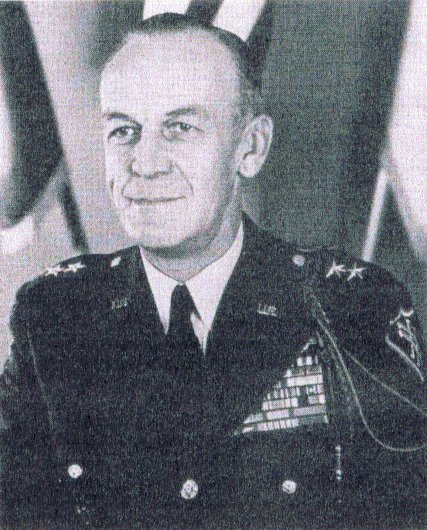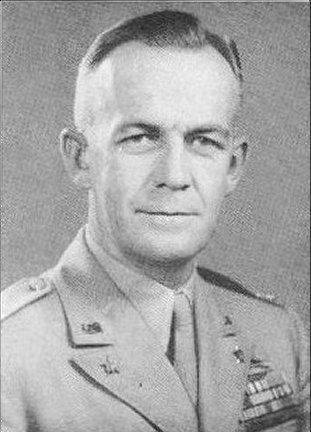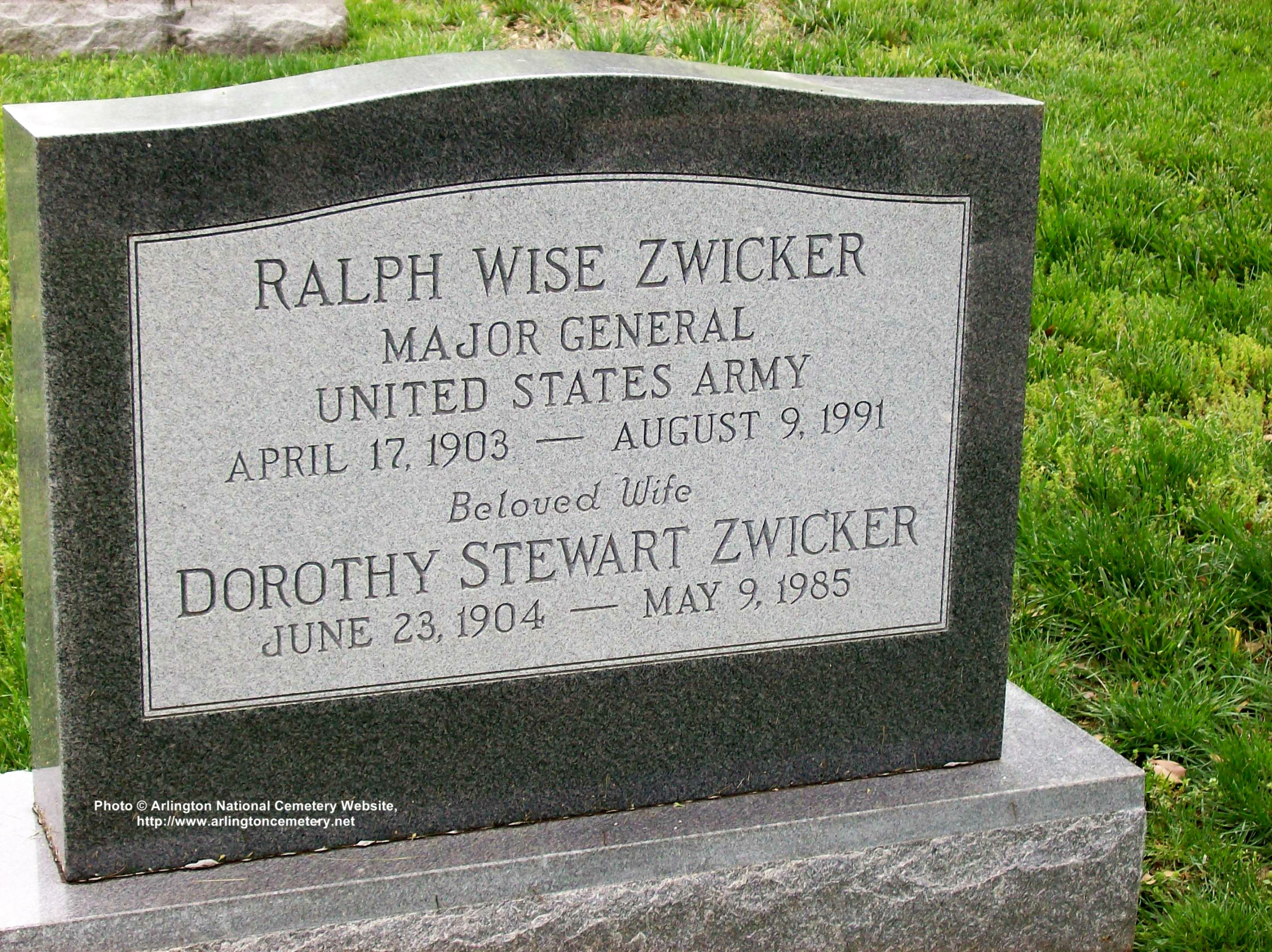MAJOR GENERAL RALPH WISE ZWICKER
General Zwicker was a soldier’s soldier. He cared for his men deeply. Of all of the commanding generals that I served under he beyond a doubt was the most about the people serving under him, After the chapel services he would stop and talk with anyone for as long as his time would permit.
The first time I talked with him it was after service and I had my fiancee with me. He treated her and myself as if we were equals. Asking how things were going. He asked us our names and my intentions toward my fiancee. I told him that I intended to marry her. She was Japanese and he said if anyone gave us any trouble to feel free to call his office. He would see what he could do to help as long as she passed the background investigation.
Ralph Wise Zwicker was born on 17 April 1903 in Stoughton, Wisconsin. Spending his boyhood in Wisconsin, he was the first Eagle Scout in Wisconsin. He graduated from high school in Madison and was a student in the college of engineering at the University of Wisconsin prior to entering the United States Military Academy in July 1923. Upon graduation on 14 June 1927, he was commissioned a 2nd Lieutenant of infantry. Exactly one month later he married Dorothy Harriet Stewart of Madison. Together they reported to his first duty station, Fort Snelling, Minnesota and assigned to the 3rd Infantry Regiment, “The Old Guard.”
General Zwicker served in the Army for 33 years. During his career he served in command assignments from Platoon Leader to Commanding General of Divisions and Commander of Camp Kilmer. From 1954 to 1957 General Zwicker was the Commander of Southwest Command at Camp Otsu, Japan. Some of his other command positions took him to Korea and Europe.
He also served in staff position from battalions to Headquarters, Department of the Army.
His first overseas assignment in July 1930 was at Schofield Barracks, Hawaii with the 35th Infantry Regiment of the famed 25th Infantry Division and the 11th tank Company. After his graduation from Company Officer’s Course at the Infantry School, Fort Benning, Georgia in 1933, he was again assigned to the 3rd Infantry Regiment at Fort Snelling.
Following his promotion to 1st Lieutenant in July he was designated Company Commander of one of the original Civilian Conservation Corps (CCC) companies.
In 1934 he was reassigned to the United States Military Academy, where he became an instructor in the Department of Military Topography and Graphs (slang drawing).
In August 1939 he was transferred to Fort Douglas, Utah and assigned as a Company Commander to the famous 38th Infantry Regiment, which he commanded in combat 5 years later. The regiment participated actively as part of the 2nd Infantry Division (also known as the Indian Head Division) at Camp Bullis and Fort Sam Houston, Texas in training and testing the new Triangular Concept of organization.
In 1941 as a Major, Zwicker was back at Fort Benning as an instructor in the Tactics Section of the Infantry School; He also finished the Command and General Staff College at Fort Leavenworth Kansas.
During the War years he had many and rewarding assignments. He was assigned duty as the G-3 of the 94th Infantry Division from the time of its organization in September 1942 to its first large scale maneuver test in November 1943.
His next Assignment was with Headquarters, Army Ground Forces in Washington D.C. as assistant to the G-3 for training.
Early in May 1944 he was in England as an observer for the Commanding General, Army Ground Forces. After participation in the assault landing on Omaha Beach on D-Day, fortunate circumstances found Colonel Zwicker assigned in mid June 1944 as the Commanding Officer, of the 38th Infantry Regiment. He participated with the 2nd Infantry Division as Regimental Commander and later as Chief of Staff for the 2nd Infantry Division from October 1944 to some time in 1945.
During the period 1944 to 1945 Colonel Zwicker received the following decorations: From the V Corps He received the Silver Star. From the Commander of the 2nd Infantry Division as Commander of the 38th Infantry Division, in 1944; Legion Merit; of 3 Bronze Star Medals; and a second Legion of Merit. Colonel Zwicker was also decorated by Great Britain; General Zwicker was awarded the British DSO for Valor on D-Day in a small amphibious vehicle (DUCK) with a driver and a radio operator-he went along the shoreline of Omaha Beach. Spotting the enemy guns that were behind the original emplacement. The Germans had place powder charges in where the original gun emplacements and set them off when they fired at landing craft to decoy Naval gun fire. He was able to radio the new positions while the DUCK was under small arms fire from the Germans and the DUCK was hit several times. It had so many bullet holes that it was a miracle that anyone got out of it alive. He also received decorations from France, Czechoslovakia and Russia.
After World War II he furthered his professional education by attending the Naval War College at Newport Rhode Island from July to December 1945. He attended the National War College from August 1946 to June 1947.
Colonel Zwicker was the assistant Chief of Staff for Operations at Headquarters Army Ground Forces, Washington DC, from December 1945 to August 1946.
Colonel Zwicker was assigned to Operation and Training Division of the Army General Staff from June 1947 to April 1949. At that time he was appointed as Deputy to The Chief of Staff for Civilian Component Affairs from April 1949 to July 1949. That is when he was transferred to the European Command Headquarters as Deputy Director of Operations and Training Division. After 2 years in this assignment, he was assigned for the next 2 years as Commander of the 18th Infantry Regiment of the 1st Infantry Division.
Colonel Zwicker returned to the United Stated in 1952. He was assigned as an instructor at the National War College.
In February 1953 he was assigned to Indiantown Gap Military Reservation, Pennsylvania as Assistant Division Commander of the 5th Infantry Division and promoted to Brigadier General in March 1953.
After a year of being the Commander of Camp Kilmer, New Jersey, he was sent to Japan in October 1954. When he arrived in Japan he was made Commander of Southwestern Command AFFE. He remained Commander of Southwestern Command until it was deactivated in March 1956. He was than assigned as G-1 of AFFE/Eight Army and remained in this position until his promotion to Major General in May 1957.
After his promotion he was assigned as Commanding General of the 24th Infantry Division in Korea. He remained the Commanding General of the 24th Infantry Division until it was deactivated in 1958 and its duties turned over to the 1st Calvary Division and he became the Commanding General of the First Calvary Division.
In May 1958 he was made Commanding General of the XX United States Army Corps (Reserve) headquarters at Fort Hayes, Ohio. His duties included Command, Training and Support of the US Army Reserve and ROTC programs in Ohio, Kentucky and West Virginia. Major General Ralph W. Zwicker retired from the Army Disabled 1 May 1960.
Major General Ralph Wise Zwicker passed away at a nursing home in Virgina 9 August 1991. He had been in the nursing home for 2 years and passed away from a heart ailment at the age of 88. Rest in peace good and faithful soldier.
He is survived by 2 sons and a daughter, his sons Lieutenant Colonel Ralph L. Zwicker US Army Retired and Richard H. Zwicker, daughter Jean Z. Durant. His wife Dorothy preceded him in passing in 1985.
Thanks to Lieutenant Colonel Ralph L Zwicker and Donald Devaney for their contribution that makes this tribute possible.
NOTE: The General’s brother, Michael Henry Zwicker, Colonel, United States Army, is buried in this gravesite as well.
ZWICKER, RALPH W
- MG US ARMY
- DATE OF BIRTH: 04/17/1903
- DATE OF DEATH: 08/09/1991
- BURIED AT: SECTION 2-E SITE 125-A
ARLINGTON NATIONAL CEMETERY
ZWICKER, DOROTHY S
- DATE OF BIRTH: 06/23/1904
- DATE OF DEATH: 05/09/1985
- BURIED AT: SECTION 2-E SITE 125-A
- ARLINGTON NATIONAL CEMETERY
- WIFE OF ZWICKER, RALPH W MG US ARMY
Michael Robert Patterson was born in Arlington and is the son of a former officer of the US Army. So it was no wonder that sooner or later his interests drew him to American history and especially to American military history. Many of his articles can be found on renowned portals like the New York Times, Washingtonpost or Wikipedia.
Reviewed by: Michael Howard



